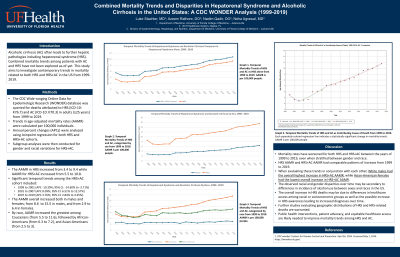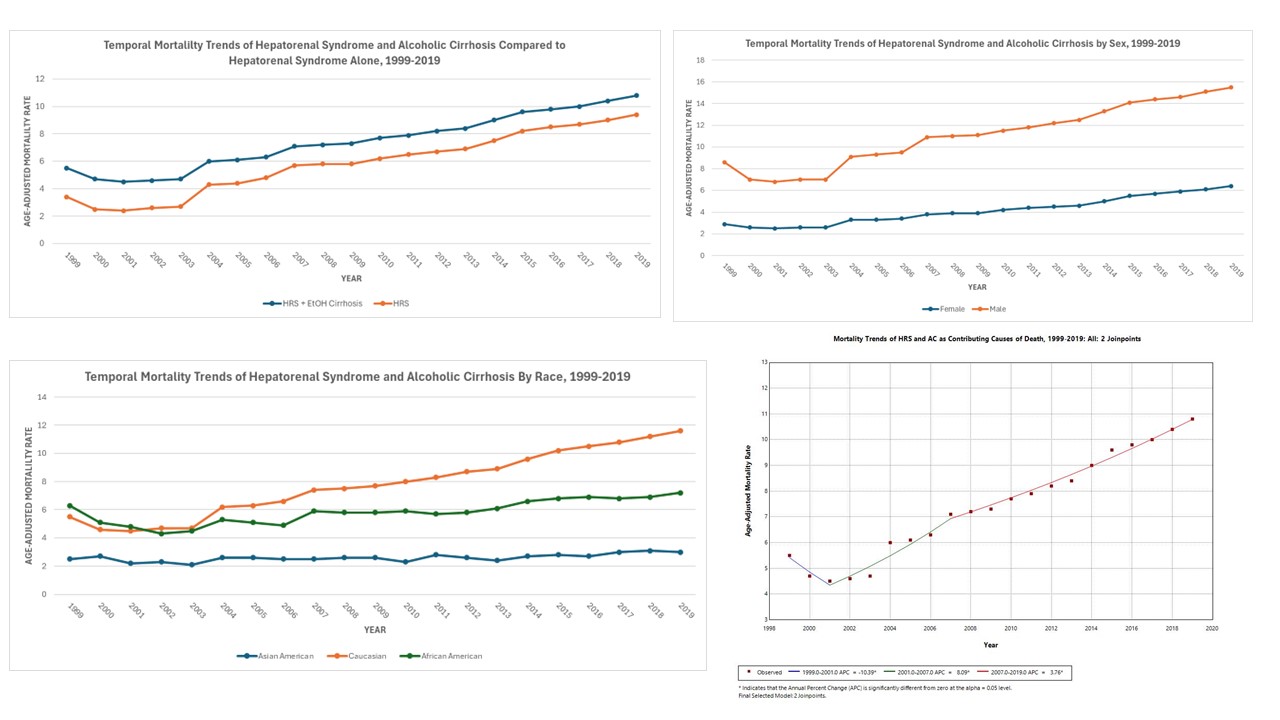Monday Poster Session
Category: Liver
P2859 - Combined Mortality Trends and Disparities in Hepatorenal Syndrome and Alcoholic Cirrhosis in the United States: A CDC WONDER Analysis (1999-2019)
Monday, October 28, 2024
10:30 AM - 4:00 PM ET
Location: Exhibit Hall E

Has Audio

Luke Stachler, MD
University of Florida College of Medicine
Jacksonville, FL
Presenting Author(s)
Luke Stachler, MD1, Azeem Rathore, DO2, Nadim A. Qadir, DO3, Neha Agrawal, MD1
1University of Florida College of Medicine, Jacksonville, FL; 2NCH Healthcare System, Naples, FL; 3University of Florida College of Medicine, Windermere, FL
Introduction: Alcoholic cirrhosis (AC) often leads to further hepatic pathologies including hepatorenal syndrome (HRS). Combined mortality trends among patients with AC and HRS have not been explored as-of-yet. This study aims to investigate contemporary trends in mortality related to both HRS and HRS+AC in the US from 1999-2019.
Methods: The CDC Wide-ranging Online Data for Epidemiologic Research (WONDER) database was queried for deaths attributed to HRS (ICD-10: K76.7) and AC (ICD-10: K70.3) in adults (≥25 years) from 1999 to 2019. Trends in age-adjusted mortality rates (AAMR) were calculated per 100,000 individuals. Annual percent changes (APCs) were analyzed using Joinpoint regression for both HRS and HRS+AC cohorts. Subgroup analyses were conducted for gender and racial variations for HRS+AC.
Results: The AAMR in AC increased from 3.4 to 9.4 while AAMR for HRS+AC increased from 5.5 to 10.8. Significant temporal trends among the HRS+AC cohort included: 1999 to 2001 (APC -10.39%; 95% CI: -14.60% to -3.71%), 2001 to 2007 (APC 8.09%; 95% CI: 6.51% to 12.57%), and 2007 to 2019 (APC 3.76%; 95% CI: 2.84% to 4.35%). The AAMR overall increased both in males and females; from 8.6 to 15.5 in males, and from 2.9 to 6.4 in females. By race, AAMR increased the greatest (from 5.5 to 11.6) among Whites, followed by African-Americans (from 6.3 to 7.2), and Asian-Americans (from 2.5 to 3).
Discussion: Mortality rates have worsened for both HRS and HRS+AC between the years of 1999 to 2019, even when stratified between gender and race. HRS AAMR and HRS+AC AAMR had comparable patterns of increase over this time period. When evaluating these trends in conjunction with each other, White males had the overall highest increase in HRS+AC AAMR, while Asian-American females had the lowest overall increase in HRS+AC AAMR. The observed racial and gender disparities over time may be secondary to differences in incidence of alcohol use between sexes and races in the US. The overall increase in HRS deaths may be due to differences in healthcare access among racial or socioeconomic groups as well as the possible increase in HRS awareness leading to increased diagnoses over time. Further studies evaluating geographic distributions of HRS and HRS-related deaths are warranted. Public health interventions, patient advocacy, and equitable healthcare access are likely needed to improve mortality trends among HRS and AC.

Disclosures:
Luke Stachler, MD1, Azeem Rathore, DO2, Nadim A. Qadir, DO3, Neha Agrawal, MD1. P2859 - Combined Mortality Trends and Disparities in Hepatorenal Syndrome and Alcoholic Cirrhosis in the United States: A CDC WONDER Analysis (1999-2019), ACG 2024 Annual Scientific Meeting Abstracts. Philadelphia, PA: American College of Gastroenterology.
1University of Florida College of Medicine, Jacksonville, FL; 2NCH Healthcare System, Naples, FL; 3University of Florida College of Medicine, Windermere, FL
Introduction: Alcoholic cirrhosis (AC) often leads to further hepatic pathologies including hepatorenal syndrome (HRS). Combined mortality trends among patients with AC and HRS have not been explored as-of-yet. This study aims to investigate contemporary trends in mortality related to both HRS and HRS+AC in the US from 1999-2019.
Methods: The CDC Wide-ranging Online Data for Epidemiologic Research (WONDER) database was queried for deaths attributed to HRS (ICD-10: K76.7) and AC (ICD-10: K70.3) in adults (≥25 years) from 1999 to 2019. Trends in age-adjusted mortality rates (AAMR) were calculated per 100,000 individuals. Annual percent changes (APCs) were analyzed using Joinpoint regression for both HRS and HRS+AC cohorts. Subgroup analyses were conducted for gender and racial variations for HRS+AC.
Results: The AAMR in AC increased from 3.4 to 9.4 while AAMR for HRS+AC increased from 5.5 to 10.8. Significant temporal trends among the HRS+AC cohort included: 1999 to 2001 (APC -10.39%; 95% CI: -14.60% to -3.71%), 2001 to 2007 (APC 8.09%; 95% CI: 6.51% to 12.57%), and 2007 to 2019 (APC 3.76%; 95% CI: 2.84% to 4.35%). The AAMR overall increased both in males and females; from 8.6 to 15.5 in males, and from 2.9 to 6.4 in females. By race, AAMR increased the greatest (from 5.5 to 11.6) among Whites, followed by African-Americans (from 6.3 to 7.2), and Asian-Americans (from 2.5 to 3).
Discussion: Mortality rates have worsened for both HRS and HRS+AC between the years of 1999 to 2019, even when stratified between gender and race. HRS AAMR and HRS+AC AAMR had comparable patterns of increase over this time period. When evaluating these trends in conjunction with each other, White males had the overall highest increase in HRS+AC AAMR, while Asian-American females had the lowest overall increase in HRS+AC AAMR. The observed racial and gender disparities over time may be secondary to differences in incidence of alcohol use between sexes and races in the US. The overall increase in HRS deaths may be due to differences in healthcare access among racial or socioeconomic groups as well as the possible increase in HRS awareness leading to increased diagnoses over time. Further studies evaluating geographic distributions of HRS and HRS-related deaths are warranted. Public health interventions, patient advocacy, and equitable healthcare access are likely needed to improve mortality trends among HRS and AC.

Figure: Mortality Trends in Hepatorenal Syndrome and Alcoholic Cirrhosis from CDC WONDER Database
Disclosures:
Luke Stachler indicated no relevant financial relationships.
Azeem Rathore indicated no relevant financial relationships.
Nadim Qadir indicated no relevant financial relationships.
Neha Agrawal indicated no relevant financial relationships.
Luke Stachler, MD1, Azeem Rathore, DO2, Nadim A. Qadir, DO3, Neha Agrawal, MD1. P2859 - Combined Mortality Trends and Disparities in Hepatorenal Syndrome and Alcoholic Cirrhosis in the United States: A CDC WONDER Analysis (1999-2019), ACG 2024 Annual Scientific Meeting Abstracts. Philadelphia, PA: American College of Gastroenterology.
